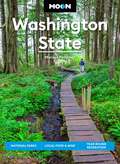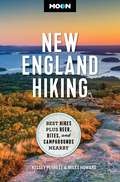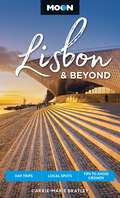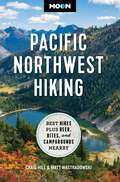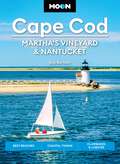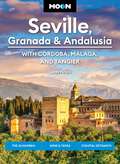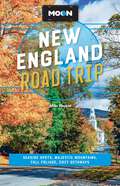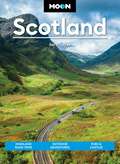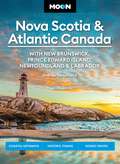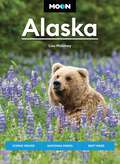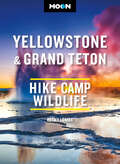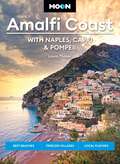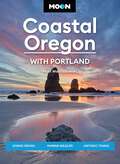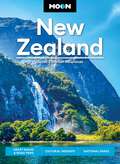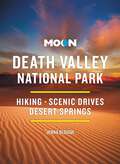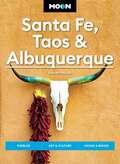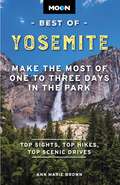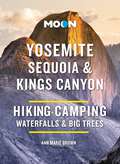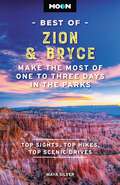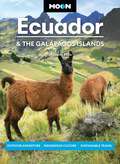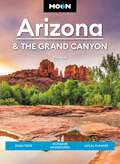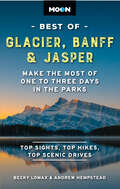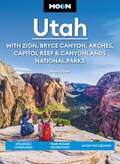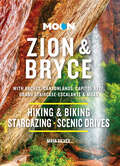- Table View
- List View
Moon Washington State: National Parks, Local Food & Wine, Year-Round Recreation (Moon U.S. Travel Guide)
by Moon Travel Guides Marissa PedersenStunning coastline, seaside towns, and a breathtaking array of natural wonders: Experience the best of the Evergreen State with Moon Washington State. Inside you'll find:Flexible itineraries, whether you're checking out the national parks, visiting the scenic Columbia River Gorge, or road-tripping the whole state Can't-miss experiences and unique activities: Watch the fishmongers at Pike Place Market, enjoy panoramic views from the iconic Space Needle, or visit the charming towns of the San Juan Islands. Sample world-class wines in Walla Walla, savor fresh seafood, and soak up the atmosphere in a cozy coffee shop Outdoor adventures: Hike through wildflower meadows in Mt. Rainier National Park, stroll through the lush Hoh Rainforest, and go sea kayaking in Friday Harbor. Take a whale watching trip, marvel at the varied landscapes of the North Cascades Scenic Byway, or bike along the Spokane River Expert insight from Washington local Marissa Pedersen on when to go, where to stay, and how to get around Full-color photos and detailed maps throughoutThorough background information on the culture, landscape, climate, and wildlife, plus handy recommendations for international visitors, families with kids, travelers of color, solo travelers, and more Focused coverage of Seattle, the Olympic Peninsula, the San Juan Islands, the North Cascades, Mount Rainier and the South Cascades, the Columbia River Gorge, and Eastern Washington With Moon's expert tips and local know-how, you can experience the best of Washington. Sticking to one spot? Try Moon Olympic Peninsula or Moon San Juan Islands. Looking for outdoor adventure? Check out Moon Pacific Northwest Hiking.About Moon Travel Guides: Moon was founded in 1973 to empower independent, active, and conscious travel. We prioritize local businesses, outdoor recreation, and traveling strategically and sustainably. Moon Travel Guides are written by local, expert authors with great stories to tell—and they can't wait to share their favorite places with you. For more inspiration, follow @moonguides on social media.
Moon New England Hiking: Best Hikes, Plus Beer, Bites, and Campgrounds Nearby (Moon Hiking Travel Guide)
by Moon Travel Guides Kelsey Perrett Miles HowardHit the trail and experience the best local adventures in Vermont, New Hampshire, Maine, Massachusetts, Rhode Island, and Connecticut with Moon New England Hiking! Inside you'll find:150 Outdoor Getaways including easy day hikes and multi-day backpacking trips Diverse Hiking Options from breathtaking seaside walks in Coastal Maine to challenging backcountry treks in the Berkshires Find Your Hike: Choose from strategic lists like the best spots for a swim, high-elevation vistas, New England oddities, and hikes with nearby breweries, plus a breakdown of the best hikes for each season The Top Outdoor Experiences: Cool off under a cascading waterfall, pick wild blueberries from a meadow, and take in views of endless fall foliage. Take a dip in the ocean after scaling the cliffs in Acadia or meander through shorebird habitats in Rhode Island. Visit a replica of Thoreau's cabin at historic Walden Pond, enjoy a peaceful afternoon on a secluded trail, and marvel at the Boston skyline from afar Nearby Fun: Relax after your hike at a local brewery, find a nearby campground, or stop for lunch at a mom n' pop eatery Essential Planning Details: Each hike is described in detail and marked with round-trip distance and hiking time, difficulty, terrain type, elevation gain, and access points Maps and Directions: Easy-to-use maps, driving directions to each trailhead, and details on where to park Full-color photos throughout Expert Advice: Seasoned hikers Miles Howard and Kelsey Perrett reveal their experienced insights, local secrets, and honest opinions of each trail Tips and Tools: Advice on gear, first aid, protecting the environment, and getting park passes, plus background information on climate, landscape, and wildlife Whether you're a veteran or a first-time hiker, Moon's comprehensive coverage and local expertise will have you gearing up for your next adventure. Exploring the region by car? Check out Moon New England Road Trip. About Moon Travel Guides: Moon was founded in 1973 to empower independent, active, and conscious travel. We prioritize local businesses, outdoor recreation, and traveling strategically and sustainably. Moon Travel Guides are written by local, expert authors with great stories to tell—and they can't wait to share their favorite places with you. For more inspiration, follow @moonguides on social media.
Moon Lisbon & Beyond: Day Trips, Local Spots, Tips to Avoid Crowds (Moon Europe Travel Guide)
by Carrie-Marie Bratley Moon Travel GuidesFrom the vibrant azulejo tiles and colorful rooftops to the warm, golden coastline, get to know the charming City of Seven Hills with Moon Lisbon & Beyond. Inside you'll find:Strategic, flexible itineraries designed for visiting top sights and local favorites, whether you have a few days, a week, or longer Must-see highlights and unique experiences: Hop on a tram to explore the hilly capital and marvel at 11th century castles. Shop for artisan treasures at a local flea market or soak up the vibrant colors of Lisbon's famous tiles at the Museu Nacional do Azulejo. Enjoy mouthwatering pasteis de Belém, order fresh grilled sardines at an outdoor bar, and people-watch as you snack on local cheese and charcuterie. Catch a traditional folk music show in a neighborhood fado house, chat with locals over a pint in a cozy pub, and sample delicious regional vintages at a hip wine bar Get outside the city: Escape the crowds with an easy day trip or short overnight stay. Venture through the fascinating Chapel of Bones in Évora, go surfing in Ericeira, relax by the tranquil river in Tomar, or marvel at grand palaces in Sintra Trusted, expert advice from longtime Portugal resident Carrie-Marie Bratley Background information on the city's history and culture, plus handy tips for getting around, traveling sustainably, avoiding crowds, and supporting local businesses Full-color photos and detailed maps throughout, plus a fold-out mapIn-depth coverage of neighborhoods, like Baixa, Chiado, Bairro Alto, and Belém, and nearby regions, including the Setúbal Peninsula, the Portuguese Riviera, and the Costa da Caparica Explore at your own pace and savor the city like a local with Moon Lisbon & Beyond. Visiting more of Europe? Check out Moon Norway or Moon Rome, Florence & Venice.About Moon Travel Guides: Moon was founded in 1973 to empower independent, active, and conscious travel. We prioritize local businesses, outdoor recreation, and traveling strategically and sustainably. Moon Travel Guides are written by local, expert authors with great stories to tell—and they can't wait to share their favorite places with you. For more inspiration, follow @moonguides on social media.
Moon Pacific Northwest Hiking: Best Hikes Plus Beer, Bites, and Campgrounds Nearby (Moon Hiking Travel Guide)
by Craig Hill Moon Travel Guides Matt WastradowskiTowering peaks, sparkling coastline, and vast old-growth forests: wherever you turn in the Pacific Northwest, adventure awaits. Pack a lunch, lace up your boots, and hit the trails with Moon Pacific Northwest Hiking. Inside you'll find:Diverse Hiking Options: Whether you plan to take breathtaking coastal walks in Oregon or challenging treks around Mount Rainier, enjoy outdoor getaways ranging from easy day hikes to multi-day backpacking trips Find Your Hike: Looking for something specific? Choose from strategic lists of the best hikes for waterfalls, wildflowers, four-legged friends, and more, plus a breakdown of the best hikes by season The Top Outdoor Experiences: Wander through the damp, dense greens of a rainforest in Olympic National Park or revel in a Mars-like red rock landscape in southeastern Oregon. Watch a stunning sunset on a beach scattered with sea stacks or gaze into the mouth of a volcano crater. Catch a glimpse of a bighorn sheep, see actual wagon ruts on the historic Oregon Trail, and stroll through fields of wildflowers. Walk behind a waterfall or take in sweeping views of the downtown Portland skyline Nearby Fun: Kick back at a local brewery after a day on the trail, spend a night under the stars at a nearby campground, or enjoy a plate of fresh oysters with an ocean view Essential Planning Details: Each hike is described in detail and marked with round-trip distance and hiking time, difficulty, terrain type, elevation gain, and access points Maps and Directions: Find easy-to-use maps, driving directions to each trailhead, and details on where to park Expert Advice: Seasoned hikers Craig Hill and Matt Wastradowski offer experienced insights, local secrets, and honest opinions of each trail Tips and Tools: Advice on gear, first aid, and camping permits, plus background information on climate, landscape, and wildlife Moon Pacific Northwest Hiking covers hikes in Washington and Oregon Whether you're a veteran or a first-time hiker, Moon's comprehensive coverage and local expertise will have you gearing up for your next adventure. Hitting the road? Check out Moon Pacific Northwest Road Trip!About Moon Travel Guides: Moon was founded in 1973 to empower independent, active, and conscious travel. We prioritize local businesses, outdoor recreation, and traveling strategically and sustainably. Moon Travel Guides are written by local, expert authors with great stories to tell—and they can't wait to share their favorite places with you. For more inspiration, follow @moonguides on social media.
Moon Cape Cod, Martha's Vineyard & Nantucket: Best Beaches, Coastal Towns, Clambakes & Lobster (Moon U.S. Travel Guide)
by Ray Bartlett Moon Travel GuidesFrom fine art galleries and fried clams to breathtaking beachside hikes, escape to the Cape with Moon Cape Cod, Martha's Vineyard & Nantucket. Inside you'll find:Strategic, flexible itineraries including a long weekend in Nantucket, a Martha&’s Vineyard getaway, and a week seeing the best of Cape Cod Fun highlights and unique experiences: Admire 19th century lighthouses and take in some local lore at the Whaling Museum. Feast on raw oysters, fried clams, and fresh fish. Kick back at an old-school drive-in theater or have a lively night at a popular drag show in Provincetown. Stroll the cobblestone streets of Nantucket or pop into the galleries and artisan studios on the Cape The top outdoor adventures: Kayak through misty marshes, spot dolphins from a sailboat, hike to cliffside bluffs, or bike the serene beach paths of Martha's Vineyard Honest advice from Cape Cod local Ray Bartlett on when to go, how to get around, and where to stay, from quiet seaside cottages to historic guest houses and posh resorts Full-color photos and detailed maps throughoutThorough background on the landscape, climate, wildlife, and culture Experience the best of the Cape with Moon Cape Cod, Martha's Vineyard & Nantucket. Exploring more of New England? Try Moon New England Road Trip. Hitting the trails? Check out Moon New England Hiking. About Moon Travel Guides: Moon was founded in 1973 to empower independent, active, and conscious travel. We prioritize local businesses, outdoor recreation, and traveling strategically and sustainably. Moon Travel Guides are written by local, expert authors with great stories to tell—and they can't wait to share their favorite places with you. For more inspiration, follow @moonguides on social media.
Moon Seville, Granada & Andalusia: The Alhambra, Wine & Tapas, Coastal Getaways (Moon Europe Travel Guide)
by Lucas Peters Moon Travel GuidesFrom stunning palaces and vibrant plazas to snowy mountains and warm beaches, soak up the magic of southern Spain with Moon Seville, Granada & Andalusia. Inside you&’ll find:Strategic, flexible itineraries including a two-week grand tour of Andalusia, shorter trips to the Pueblos Blancos or Costa del Sol, and more Must-see highlights and unique experiences: Wander among the intricate tiles and beautiful gardens of Granada&’s Alhambra and marvel at the soaring arches of Cordoba&’s Mezquita-Catedral. Row a boat through Seville&’s Plaza de España, ski in the Sierra Nevada, or relax on a sunny beach. Enjoy a flamenco performance, experience a Semana Santa procession, or party at Carnival in Cadiz The best local flavors: Savor fresh seafood, sample unique tapas, and feast on jamón ibérico. Cool down with refreshing gazpacho or warm up with churros and piping hot chocolate. Attend an olive oil tasting, tour a sherry bodega, or sip local wine Ideas for side trips, including Malaga, Tangier, Gibraltar, Cadiz, the Pueblos Blancos, and more Expert advice from writer and photographer Lucas Peters, who has spent the past two decades traveling in Europe Full-color photos and detailed maps throughoutBackground information on the landscape, history, and cultural customs of each city Handy tools such as visa information, a Spanish phrasebook, and tips for families, travelers with disabilities, women travelers, travelers of color, LGBTQ+ travelers, and seniors Experience the best of southern Spain your way with Moon Seville, Granada & Andalusia. Exploring more of Europe? Check out Moon Portugal or Moon Sicily. Expanding your trip? Try Moon Morocco.About Moon Travel Guides: Moon was founded in 1973 to empower independent, active, and conscious travel. We prioritize local businesses, outdoor recreation, and traveling strategically and sustainably. Moon Travel Guides are written by local, expert authors with great stories to tell—and they can't wait to share their favorite places with you. For more inspiration, follow @moonguides on social media.
Moon New England Road Trip: Seaside Spots, Majestic Mountains, Fall Foliage, Cozy Getaways (Moon Road Trip Travel Guide)
by Moon Travel Guides Miles HowardFrom the misty mountains in Maine to the coastal charms of Cape Cod, there's no shortage of adventure in New England: Get ready to hit the road with Moon New England Road Trip. Inside you'll find:Multiple Routes: Choose from flexible road trips like a fall foliage tour, getaways from the cities, or the ultimate two-week route through all of New England Eat, Sleep, Stop and Explore: With lists of the best hikes, views, eateries, and more, you can trek among spruce trees in the White Mountains, cycle through Acadia National Park, or cruise down bucolic lanes of Woodstock. Take to the sea and spot humpback whales and puffin colonies, shop for wood-fired maple syrup, or snag a buttery lobster roll after a day at the beach. Dive into Boston's revolutionary history, sample farm-fresh produce in the Berkshires, party in Providence, or sip your way through some of the area's best microbreweries Maps and driving tools: Easy-to-use maps keep you oriented on and off the highway, along with site-to-site mileage, driving times, detailed directions, and full-color photos throughoutLocal Expertise: Lifelong New Englander and road warrior Miles Howard shares the local secrets of Maine, New Hampshire, Vermont, Massachusetts, New York, and Rhode Island Planning Your Trip: Know when and where to get gas, how to avoid traffic, tips for driving in different road and weather conditions, and suggestions for LGBTQ travelers, seniors, and road trippers with kids With Moon New England Road Trip's practical tips, detailed itineraries, and insider's view, you're ready to fill up the tank and hit the road. Looking to explore more of America on wheels? Try Moon Blue Ridge Parkway Road Trip! Spending more time in the city? Check out Moon 52 Things to Do in Boston.About Moon Travel Guides: Moon was founded in 1973 to empower independent, active, and conscious travel. We prioritize local businesses, outdoor recreation, and traveling strategically and sustainably. Moon Travel Guides are written by local, expert authors with great stories to tell—and they can't wait to share their favorite places with you. For more inspiration, follow @moonguides on social media.
Moon Scotland: Highland Road Trips, Outdoor Adventures, Pubs & Castles (Moon Europe Travel Guide)
by Sally Coffey Moon Travel GuidesDramatic landscapes, hauntingly beautiful ruins, and stirring myths and legends: See for yourself why this evocative country has inspired art and folklore for centuries with Moon Scotland. Inside you&’ll find:Flexible itineraries including a journey through the Highlands and islands, day-by-day itineraries in Glasgow and Edinburgh, a tour of Scotland&’s six World Heritage Sites, and more Strategic advice, whether you&’re looking to castle-hop, trace your ancestry, go cliff-diving, or stroll through misty villages Must-see highlights and unique experiences: Walk along Edinburgh's historic Royal Mile, or climb the Arthur's Seat peak. Explore Neolithic burial chambers and rugged archipelagos in the north, follow the Malt Whisky Trail in Speyside, or hop on the West Highland Railway, one of the world&’s most beautiful train rides. Catch a traditional music performance in Glasgow or chat with locals at a corner pub over folk music and a pint. Hike through wild moors and pine forests to deserted villages on Skye, play one of the oldest golf courses in the world, or take a seaplane over Loch Lomond for dramatic views of the Highlands Honest tips from Scotland expert Sally Coffey Full-color photos and detailed maps throughoutBackground information on Scotland&’s landscape, history, and cultural customs In-depth coverage of Edinburgh, Glasgow, Southern, Central, and Northeast Scotland, Loch Lomond, Inverness, Orkney & Shetland, the Central Highlands and the Isle of Skye, and the Outer Hebrides Experience the best of Scotland with Moon&’s practical tips and expert insight. Continuing your journey? Check out Moon Ireland. About Moon Travel Guides: Moon was founded in 1973 to empower independent, active, and conscious travel. We prioritize local businesses, outdoor recreation, and traveling strategically and sustainably. Moon Travel Guides are written by local, expert authors with great stories to tell—and they can't wait to share their favorite places with you. For more inspiration, follow @moonguides on social media.
Moon Nova Scotia & Atlantic Canada: Coastal Getaways, Historic Towns, Scenic Drives (Moon Canada Travel Guide)
by Andrew Hempstead Moon Travel GuidesCatch a glimpse of the world's rarest whales, hike through lush forests, or wander around quaint historic towns: the very best of the northeast is yours with Moon Nova Scotia & Atlantic Canada. Inside you'll find:Strategic, flexible itineraries including scenic drives, ocean excursions, and the best of the Maritimes Top experiences and activities: Take in stunning scenery while driving the Cabot Trail or the Irish Loop, visit an active archeological dig at the Colony of Avalon, or study artifacts from the Titanic at the Maritime Museum of the Atlantic. Savor local oysters at a waterfront restaurant, sample seasonal beers at North America's oldest operating brewery, and refuel with a hearty rappie pie after a day of touring Nova Scotia Best outdoor adventures: Bike through UNESCO-protected towns or cruise past massive icebergs. Cross-country ski and snowmobile in Sugarloaf Park or skate on frozen lakes near Halifax. Hike along rocky shoreline or through wildflower-filled river valleys. Kayak to a secluded island for a picnic lunch and camp out under the stars at oceanside parks Expert advice from Canadian author Andrew Hempstead on when to go, where to stay, and how to get around Full-color photos and detailed maps throughoutBackground information on the environment, culture, and history In-depth coverage of Nova Scotia, New Brunswick, Prince Edward Island, Newfoundland, and Labrador Get to know the best of Nova Scotia and Atlantic Canada with Moon's local insight and expert tips. Exploring more of Canada? Check out Moon Canadian Rockies or Moon Victoria & Vancouver Island.About Moon Travel Guides: Moon was founded in 1973 to empower independent, active, and conscious travel. We prioritize local businesses, outdoor recreation, and traveling strategically and sustainably. Moon Travel Guides are written by local, expert authors with great stories to tell—and they can't wait to share their favorite places with you. For more inspiration, follow @moonguides on social media.
Moon Alaska: Scenic Drives, National Parks, Best Hikes (Moon U.S. Travel Guide)
by Lisa Maloney Moon Travel GuidesRemote, wild, and all-around otherworldly, Alaska promises unforgettable adventure. Discover the heart of "The Last Frontier" with Moon Alaska. Inside you'll find:Strategic itineraries, whether you have a week to hit the top sights or a month to explore the whole state The top outdoor activities: Embark on a glacier hike, cast your line in the halibut capital of the world, or take an intrepid "flightseeing" tour to secluded glacier landings in Denali National Park. Experience the thrill of spotting wild bears, moose, wolves, or even a walrus, or hop on a boat at Columbia Glacier to watch sea otters, harbor seals, and whales glide through the water. Kayak on tranquil sounds and secluded lakes or camp under a crystal-clear sky full of stars Unique experiences: Learn about Alaska Native cultures, visit quirky small towns, and discover the best spots to witness the enchanting northern lights Honest advice from Anchorage local and outdoor aficionado Lisa Maloney on when to go, what to pack, and where to stay, from campsites and hostels to B&Bs and resort fishing lodges Full-color photos and detailed maps throughout, plus a full-color foldout mapHow to get there and get around by plane, train, ferry, cruise ship, or guided tour Thorough background on the culture, climate, wildlife, local customs, and history, plus health and safety information With Moon Alaska's practical tips and expert insight, you can find your adventure. Headed to Canada? Try Moon Vancouver & Canadian Rockies Road Trip or Moon Victoria & Vancouver Island.About Moon Travel Guides: Moon was founded in 1973 to empower independent, active, and conscious travel. We prioritize local businesses, outdoor recreation, and traveling strategically and sustainably. Moon Travel Guides are written by local, expert authors with great stories to tell—and they can't wait to share their favorite places with you. For more inspiration, follow @moonguides on social media.
Moon Yellowstone & Grand Teton: Hiking, Camping, Wildlife (Moon National Parks Travel Guide)
by Becky Lomax Moon Travel GuidesForge your way through forests, across mountain peaks, past geysers, and more with Moon Yellowstone & Grand Teton. Inside you'll find:Flexible itineraries: Adventure-packed ideas ranging from one day in each national park to a week-long road trip covering both The best hikes in Yellowstone & Grand Teton: Detailed descriptions, mileage and elevation gains, and backpacking options Experience the outdoors: Marvel at the steam-spewing Old Faithful geyser or take a horseback ride to panoramic lakeside views. Hike through alpine forests to rushing waterfalls and catch a glimpse of wild bison, elk, wolves, or bears. Bask in the colorful radiance of Grand Prismatic Spring or stroll the boardwalks along Mammoth Hot Springs. Climb to Inspiration Point for breathtaking views of Jackson Hole and Jenny Lake, explore the quirky nearby towns, or discover the best spots to hit the slopes during the winter season How to get there: Up-to-date information on gateway towns, park entrances, park fees, and tours Where to stay: Campgrounds, resorts, and more both inside and outside the park Planning tips: When to go, what to pack, safety information, and how to avoid the crowds, with full-color photos and detailed maps throughoutExpertise and know-how: Explore both national parks with outdoors expert and former park guide Becky Lomax Helpful background on the indigenous cultures, landscape, plants and animals, and history of the region Find your adventure in Yellowstone & Grand Teton National Parks with Moon. Visiting more of North America's national parks? Try Moon Glacier National Park or Moon USA National Parks. About Moon Travel Guides: Moon was founded in 1973 to empower independent, active, and conscious travel. We prioritize local businesses, outdoor recreation, and traveling strategically and sustainably. Moon Travel Guides are written by local, expert authors with great stories to tell—and they can't wait to share their favorite places with you. For more inspiration, follow @moonguides on social media.
Moon Amalfi Coast: Best Beaches, Timeless Villages, Local Flavors (Moon Europe Travel Guide)
by Laura Thayer Moon Travel GuidesFrom the pastel rooftops of Positano to the soaring peak of Monte Solaro, immerse yourself in la dolce vita with Moon Amalfi Coast. Inside you'll find:Flexible itineraries for spending five to seven days on the Amalfi Coast, whether you want to island-hop in the Gulf of Naples or spend your days hiking and sunbathing in Amalfi Must-see highlights and unique experiences: Swim in turquoise waters, relax on sun-soaked beaches, or hop on a boat and cruise past cliffs, coves, and secret caves. Go underground to see ancient ruins in Naples or climb the towers of medieval castles. Take a day trip to Pompeii and hike to the top of Mount Vesuvius, ride a chairlift to the summit of Monte Solaro, or unwind in the natural hot springs that dot the island of Ischia The best local flavors: Stroll quiet village streets where the scent of Sunday ragù fills the air, feast on fresh seafood steps from the Mediterranean, sip local limoncello on a sunny terrace, and chow down on authentic Neapolitan pizza Honest suggestions from Amalfi local Laura Thayer on where to stay, what to eat, and how to get around Full-color photos and detailed maps throughoutBackground information on the landscape, history, and cultural customs of the Amalfi Coast Handy tools including an Italian phrasebook and tips for seniors and traveling with children With Moon Amalfi Coast's practical tips and local insight on the best things to see and do, you can experience the best of the Amalfi Coast. Exploring more of Italy? Check out Moon Southern Italy or Moon Rome, Florence & Venice.About Moon Travel Guides: Moon was founded in 1973 to empower independent, active, and conscious travel. We prioritize local businesses, outdoor recreation, and traveling strategically and sustainably. Moon Travel Guides are written by local, expert authors with great stories to tell—and they can't wait to share their favorite places with you. For more inspiration, follow @moonguides on social media.
Moon Coastal Oregon: Scenic Drives, Marine Wildlife, Historic Towns (Travel Guide)
by Moon Travel Guides Matt WastradowskiFrom stunning coastline to charming towns to wildlife watching, find your adventure with Moon Coastal Oregon. Inside you'll find:Flexible itineraries, including a weeklong road trip to experience the best of the Oregon Coast The top outdoor adventures: Go tidepooling, watch for migrating whales, and see hundreds of sea lions. Hike along epic coastal dunes, take a surfing lesson, and catch a sunset at iconic Haystack Rock. Join a fishing charter, camp beside the ocean, or take a jet boat tour to spot wildlife on the Rogue River. Can't-miss experiences and unique activities: Feast on fresh seafood in quaint seaside towns, check out Astoria's craft beer scene, or try tasty treats at the famous Tillamook cheese factory. Climb to the top of historic lighthouses, explore a shipwreck, and learn about local maritime history. Expert insight from Oregon local Matt Wastradowski on when to go, how to get around, and where to stay Full-color photos and detailed maps throughoutThorough background information on the culture, landscape, climate, and wildlife, plus handy recommendations for international visitors, families with kids, travelers of color, women travelers, and more With Moon's expert tips and local know-how, you can experience the best of Coastal Oregon. Exploring more of the state? Try Moon Oregon or Moon Columbia River Gorge & Mount Hood. Looking for outdoor adventure? Check out Moon Oregon Hiking.About Moon Travel Guides: Moon was founded in 1973 to empower independent, active, and conscious travel. We prioritize local businesses, outdoor recreation, and traveling strategically and sustainably. Moon Travel Guides are written by local, expert authors with great stories to tell—and they can't wait to share their favorite places with you. For more inspiration, follow @moonguides on social media.
Moon Florida Gulf Coast: Best Beaches, Wildlife, Everglades Adventures (Moon U.S. Travel Guide)
by Joshua Lawrence Kinser Moon Travel GuidesWhether you're kayaking through mangroves, bodysurfing with manta rays, or sunbathing with a piña colada in hand, soak up the Sunshine State with Moon Florida Gulf Coast. Inside you'll find: Flexible itineraries including a 5-day family vacation, a baseball spring training trip, and a 10-day road trip covering all 700 miles of the Florida Gulf Coast The best spots for outdoor adventures like kayaking, hiking, biking, bird-watching, and fishing, and the best beaches for swimming, sunsets, and seclusion Top activities and unique experiences: Discover the vibrant performing arts scene in Sarasota or stroll through quaint riverfront towns and secluded island enclaves. Unwind on shell-scattered beaches or spot gators in the swampy Everglades. Ride the coasters at Busch Gardens, browse art galleries in Naples, or catch a college baseball game during Spring Training. Sail through the canals of Tampa, kick back at a beachfront oyster bar, and sip a local brew as the sun sets over the ocean Expert advice from Florida local Joshua Lawrence Kinser on where to stay, what to eat, and how to get around by car, bus, or boat Full-color photos and detailed maps throughoutBackground information on the Gulf Coast's landscape, wildlife, history, and culture Experience the best of Florida's Gulf Coast with Moon. For more of the Sunshine State, try Moon Florida Keys.About Moon Travel Guides: Moon was founded in 1973 to empower independent, active, and conscious travel. We prioritize local businesses, outdoor recreation, and traveling strategically and sustainably. Moon Travel Guides are written by local, expert authors with great stories to tell—and they can't wait to share their favorite places with you. For more inspiration, follow @moonguides on social media.
Moon New Zealand: Great Walks & Road Trips, Cultural Insights, National Parks (Moon Asia & Pacific Travel Guide)
by Jamie Christian Desplaces Moon Travel GuidesFrom snowy mountains to golden beaches, beauty awaits around every bend on these dramatic islands. Find your adventure with Moon New Zealand. Inside you'll find:Strategic, flexible itineraries, including a trip to experience both the North and South Islands in 16 days The top spots for outdoor adventures, like surfing, mountain biking, and trekking the Great Walks, as well as tips for taking an epic road trip. Go bungee jumping or paragliding, soak in refreshing thermal pools, or embark on a multi-day trek to rugged coasts, glacial valleys, volcanoes, and fjords Can't-miss sights and unique experiences: Cruise the hypnotic black waters of the Milford Sound, spot wild dolphins, kiwis, and blue penguins, and explore the sprawling Waitomo Caves lit by twinkling glowworms. Sample local sauvignon blancs in Marlborough and craft beers in Wellington, or sip cider in the Shire. Learn about Polynesian culture and history, marvel at Māori carvings, and experience a traditional hangi meal How to experience New Zealand like an insider, support local and sustainable businesses, avoid crowds, and respectfully engage with indigenous culture, with expert insight from Auckland local Jamie Christian Desplaces Full-color photos and detailed maps throughout, plus a full-color detachable map Essential background information on the landscape, climate, wildlife, and history, as well as common customs and etiquette Travel tips: When to go, how to get around, and where to stay, plus advice for seniors, families with children, visitors with disabilities, and LGBTQ+ travelers Experience the best of New Zealand with Moon's expert advice and local insight. Visiting more of the South Pacific? Check out Moon Tahiti & French Polynesia.About Moon Travel Guides: Moon was founded in 1973 to empower independent, active, and conscious travel. We prioritize local businesses, outdoor recreation, and traveling strategically and sustainably. Moon Travel Guides are written by local, expert authors with great stories to tell—and they can't wait to share their favorite places with you. For more inspiration, follow @moonguides on social media.
Moon Death Valley National Park: Hiking, Scenic Drives, Desert Springs (Moon National Parks Travel Guide)
by Jenna Blough Moon Travel GuidesTrek across salt flats, scale towering rocks, and explore the marble canyons of this otherworldly landscape with Moon Death Valley National Park. Inside you'll find:Flexible Itineraries: Easy-to-follow itineraries for seeing the best of Death Valley in one day or one week, plus lists of the best scenic drives, desert oases, stargazing spots, and more The Best Hikes in Death Valley: Detailed trail descriptions, mileage and elevation gains, and backpacking options Experience the Outdoors: Hike through forested trails to sweeping canyon views and discover abandoned mining camps, remote ghost towns, and hidden springs. Go four-wheeling in the backcountry and admire surreal salt flats, rock formations, and sculpted sand dunes, and find the best vistas for that perfect sunset photo-op How to Get There: Up-to-date information on gateway towns, park entrances, park fees, and tours Where to Stay: Spend the night in a nearby hotel, or sleep under the stars with campgrounds both inside and outside the park Planning Tips: When to go, what to pack, safety information, and how to avoid the crowds, with full-color photos and detailed maps throughout Expertise and Know-How: Explore the park with Death Valley expert Jenna Blough Experience the best of Death Valley National Park with Moon. Visiting more of North America's national parks? Try Moon Joshua Tree & Palm Springs. Trying to hit them all? Check out Moon USA National Parks.About Moon Travel Guides: Moon was founded in 1973 to empower independent, active, and conscious travel. We prioritize local businesses, outdoor recreation, and traveling strategically and sustainably. Moon Travel Guides are written by local, expert authors with great stories to tell—and they can't wait to share their favorite places with you. For more inspiration, follow @moonguides on social media.
Moon Santa Fe, Taos & Albuquerque: Pueblos, Art & Culture, Hiking & Biking (Moon U.S. Travel Guide)
by Steven Horak Moon Travel GuidesExplore the eccentric art installations, historic adobe pueblos, and rugged high desert trails of the Land of Enchantment with Moon Santa Fe, Taos & Albuquerque. Inside you'll find:Flexible itineraries for art-lovers, outdoors enthusiasts, and more, including weekend getaways and a six-day road trip to see all three cities Outdoor adventures: Race down the slopes of Taos Ski Valley or mountain bike through stands of piñon and juniper near Santa Fe. Hike through thick alpine forests, raft the wild rapids of the Rio Grande Gorge, or marvel at the best view in New Mexico from a hot air balloon. Wander around the archeological sites and cave apartments of Bandelier National Monument, spot elk in Valles Caldera National Preserve, or trek alongside ancient rock carvings at Petroglyph National Monument Top experiences and unique activities: Mingle with local artists in the vibrant galleries of Santa Fe, visit Georgia O'Keefe's studio at Ghost Ranch, and relax at a world-class spa. Observe a traditional dance ceremony at a pueblo, admire handmade art and jewelry at the Santa Fe Indian Market, and learn about Native American history at one of the region's many cultural museums. Take a scenic ride on a historic steam-driven train or glide above Albuquerque on the longest aerial tram in the Americas Tastes of the Southwest: Dive into traditional New Mexican dishes drenched in spicy red and green chile sauces or indulge in a juicy green chile cheeseburger. Sip on a sunset margarita at a mellow open-air bar or taste local spirits in a trendy cocktail lounge. Take a culinary tour of Santa Fe's growing food truck scene or explore Albuquerque's lively beer culture Expert insight from Santa Fe local Steven Horak Vibrant full-color photos and detailed maps throughoutHelpful background information on the landscape, wildlife, climate, and local culture With Moon Santa Fe, Taos & Albuquerque's practical tips and local insight, you can experience New Mexico your way. Exploring more of the Southwest? Try Moon Phoenix, Scottsdale & Sedona or Moon Southwest Road Trip. Hitting the parks? Try Moon Grand Canyon or Moon Zion & Bryce.About Moon Travel Guides: Moon was founded in 1973 to empower independent, active, and conscious travel. We prioritize local businesses, outdoor recreation, and traveling strategically and sustainably. Moon Travel Guides are written by local, expert authors with great stories to tell—and they can't wait to share their favorite places with you. For more inspiration, follow @moonguides on social media.
Moon Best of Yosemite: Make the Most of One to Three Days in the Park (Moon Best of Travel Guide)
by Ann Marie Brown Moon Travel GuidesWhether you're visiting the park for a day hike or spending a long weekend under the stars, escape to the great outdoors with Moon Best of Yosemite. Inside you'll find:Easy itineraries for one to three days in Yosemite National Park, from a morning drive along the Tioga Pass Road, to a day hike along the Panorama Trail, to a full weekend exploring the park The top hikes in Yosemite: Whether you're looking to stretch your legs for a couple hours or challenge yourself to an epic trek, you'll find trailheads, detailed trail descriptions, individual maps, mileage, and elevation gains Can't-miss experiences: Make it the perfect getaway for you with the best waterfalls, views, picnic spots, and more. Ride the open-air tram through Yosemite Valley or hike downhill from Glacier Point past roaring waterfalls. Admire the towering trees in the Mariposa Grove of Giant Sequoias, or spot black bears and bighorn sheep Stunning full-color photos and detailed maps throughout, plus a full-color foldout mapEssential planning tips: Find out when to go, where to stay, and what to pack, plus up-to-date information on entrance fees, reservations, and safety advice Know-how from outdoorswoman and Yosemite expert Ann Marie BrownMake the most of your adventure with Moon Best of Yosemite. Spending more time in the park or expanding your trip? Try Moon Yosemite, Sequoia & Kings Canyon. Visiting more of North America's incredible national parks? Try Moon USA National Parks.About Moon Travel Guides: Moon was founded in 1973 to empower independent, active, and conscious travel. We prioritize local businesses, outdoor recreation, and traveling strategically and sustainably. Moon Travel Guides are written by local, expert authors with great stories to tell—and they can't wait to share their favorite places with you. For more inspiration, follow @moonguides on social media.
Moon Yosemite, Sequoia & Kings Canyon: Hiking, Camping, Waterfalls & Big Trees (Moon National Parks Travel Guide)
by Ann Marie Brown Moon Travel GuidesExplore granite domes, thundering waterfalls, and towering trees: Moon Yosemite, Sequoia & Kings Canyon reveals the best of these stunning national parks. Inside you'll find:Flexible Itineraries: Unique and adventure-packed ideas for day hikers, winter visitors, families with kids, campers, and more The Best Hikes in Each Park: Detailed hike descriptions, individual trail maps, mileage and elevation gains, and backpacking options Experience the Outdoors: Ride the open-air tram through Yosemite Valley or hike downhill from Glacier Point past roaring waterfalls. Drive the legendary Generals Highway or take a scenic bike ride to pristine lakes (and yes, more waterfalls!). Go for a horse-drawn wagon ride on a history tour or take a rock-climbing lesson. Walk among the goliaths of Sequoia's Giant Forest and stop at a historic lodge for dinner and a well-deserved drink How to Get There: Up-to-date information on traveling between the parks, gateway towns, park entrances, park fees, and tours Where to Stay: From campgrounds and rustic lodges to the majestic Ahwahnee, find the best spots to kick back, both inside and outside the parks Planning Tips: When to go, what to pack, safety information, and how to avoid the crowds, with full-color photos and easy-to-use maps throughout Expertise and Know-How from seasoned explorer and outdoor expert Ann Marie Brown Find your adventure in Yosemite, Sequoia, and Kings Canyon national parks with Moon. Visiting more of North America's incredible national parks? Try Moon USA National Parks or Moon Death Valley National Park. Hitting the road? Try Moon Northern California Road Trips.About Moon Travel Guides: Moon was founded in 1973 to empower independent, active, and conscious travel. We prioritize local businesses, outdoor recreation, and traveling strategically and sustainably. Moon Travel Guides are written by local, expert authors with great stories to tell—and they can't wait to share their favorite places with you.
Moon Best of Zion & Bryce: Make the Most of One to Three Days in the Parks (Moon Best of Travel Guide)
by Moon Travel Guides Maya SilverWhether you're stopping for a day hike or spending a long weekend under the stars, escape to the great outdoors with Moon Best of Zion & Bryce. Inside you'll find:Easy itineraries for one to three days in Zion and Bryce Canyon National Parks, from a morning hike to Weeping Rock, to a day of river rafting, to a weekend exploring both parks with mix-and-match itinerariesThe top hikes in Zion & Bryce: Whether you're looking to stretch your legs for a couple hours or challenge yourself to an epic trek, you'll find trailheads, detailed trail descriptions, individual maps, mileage, and elevation gains Can't-miss experiences: Make it the perfect getaway for you with the best views, picnic spots, and more. Snap a pic on a sunrise hike or get your adrenaline pumping on a white-water rafting excursion down the Colorado River. Explore the beautiful remains of ancient Native American rock art throughout the parks and learn about the Indigenous culture of the area Stunning full-color photos and maps throughout, plus a full-color foldout mapEssential planning tips: Find out when to go, where to stay, and what to pack, plus up-to-date information on entrance fees, reservations, and safety advice Know-how from Zion and Bryce expert Maya SilverMake the most of your adventure with Moon Best of Zion & Bryce. Spending more time in the parks? Check out Moon Zion & Bryce.About Moon Travel Guides: Moon was founded in 1973 to empower independent, active, and conscious travel. We prioritize local businesses, outdoor recreation, and traveling strategically and sustainably. Moon Travel Guides are written by local, expert authors with great stories to tell—and they can't wait to share their favorite places with you.
Moon Ecuador & the Galápagos Islands: Outdoor Adventure, Indigenous Culture, Sustainable Travel (Moon Latin America & Caribbean Travel Guide)
by Bethany Pitts Moon Travel GuidesCanoe through the Amazon, explore the bustling capital of Quito, snorkel in the Galápagos, or kick back on the coast: Embark on an unforgettable adventure with Moon Ecuador & the Galápagos Islands. Inside you'll find:Flexible itineraries for spending time in the Sierras, the Amazon, the coast, Quito, and the Galápagos Islands Must-see highlights and unique experiences: Hike through the Amazon rainforest, paddle across lily-covered lagoons, and spot camian, tapir, or pink river dolphins. Dive with hammerhead sharks in the Galápagos, cycle the epic waterfall route in Baños, and watch the sun rise over the peaks where the Amazon meets the Andes. Wander cobbled colonial streets and gaze up at snow-capped volcanoes rising from wildflower-strewn grasslands. Take a surfing lesson in Montañita, and relax on the beach with a mojito in hand How to ethically experience Ecuador like an insider, support local and sustainable businesses, and respectfully engage with the indigenous communities, including those with shamanic traditions Expert insight from local author Bethany Pitts on what to eat, how to get around, where to stay, and how to avoid crowds Full-color photos and detailed maps throughout Reliable background on the landscape, climate, wildlife, and history, as well as health and safety advice and common customs and etiquette Handy tools including a Spanish phrasebook, volunteer opportunities, packing suggestions, and travel tips for families with kids, seniors, travelers with disabilities, and LGBTQ travelers With Moon Ecuador & the Galápagos Islands' practical tips and local know-how, you can plan your trip your way. Heading to Central America? Check out Moon Costa Rica. Sticking to the islands? Try Moon Galápagos Islands.About Moon Travel Guides: Moon was founded in 1973 to empower independent, active, and conscious travel. We prioritize local businesses, outdoor recreation, and traveling strategically and sustainably. Moon Travel Guides are written by local, expert authors with great stories to tell—and they can't wait to share their favorite places with you. For more inspiration, follow @moonguides on social media.
Moon Arizona & the Grand Canyon: Road Trips, Outdoor Adventures, Local Flavors (Moon U.S. Travel Guide)
by Tim Hull Moon Travel GuidesVast open spaces, dreamy canyons, and colorful culture: experience it all with Moon Arizona & the Grand Canyon. Inside you'll find:Flexible itineraries from a Grand Canyon adventure to two weeks exploring the whole state The best road trips in Arizona, including historic Route 66 and scenic byways The top hikes, whether you're looking for treks near Phoenix or Tucson, a multi-day expedition into the depths of the Grand Canyon, or trails in Red Rock Country, complete with distance, duration, difficulty level, and elevation gain Can't-miss highlights and unique experiences: Discover hidden streams on a hike through high-desert forests or find the best spots to hit the slopes in winter. Visit Ancestral Puebloan cliff cities and learn about Arizona's indigenous cultures or stroll through charming historic towns. Marvel at the red rock cliffs around Sedona, watch your favorite MLB team play during Spring Training, and sample Southwest cuisine from spicy enchiladas to Sonoran hot dogs Expert insight from Arizona local Tim Hull on when to go, where to stay, and how to get around, including detailed coverage of gateway cities to the Grand Canyon and sustainable travel tips Full-color photos and detailed maps throughoutPractical background on Arizona's landscape, climate, wildlife, and culture Find your adventure with Moon Arizona & the Grand Canyon. Seeing more of the Southwest? Check out Moon New Mexico or Moon Phoenix, Scottsdale & Sedona. Hitting the road? Try Moon Southwest Road Trip or Moon Route 66 Road Trip.About Moon Travel Guides: Moon was founded in 1973 to empower independent, active, and conscious travel. We prioritize local businesses, outdoor recreation, and traveling strategically and sustainably. Moon Travel Guides are written by local, expert authors with great stories to tell—and they can't wait to share their favorite places with you. For more inspiration, follow @moonguides on social media.
Moon Best of Glacier, Banff & Jasper: Make the Most of One to Three Days in the Parks (Travel Guide)
by Becky Lomax Andrew Hempstead Moon Travel GuidesWhether you're stopping for a day hike or spending a long weekend under the stars, escape to the great outdoors with Moon Best of Glacier, Banff & Jasper. Inside you'll find:Easy itineraries for one to four days in Glacier, Banff, and Jasper national parks, from a scenic drive along Going-to-the-Sun Road, to a day of hiking through glacial valleys, to a weekend exploring the best of all three parks with mix-and-match itinerariesThe top hikes in Glacier, Banff, and Jasper: Whether you're looking to stretch your legs for a couple hours or challenge yourself to an epic trek, you'll find trailheads, detailed trail descriptions, individual maps, mileage, and elevation gains Can't-miss experiences: Make it the perfect getaway for you with the best views, picnic spots, and more. Trek through fields of alpine wildflowers, walk beneath waterfalls, get your adrenaline pumping on the Glacier Skywalk, and spot wild moose or grizzlies roaming the mountainside Stunning full-color photos and maps throughout, plus a full-color foldout mapEssential planning tips: Find out when to go, where to stay, and what to pack, plus up-to-date information on entrance fees, border crossing, reservations, and safety advice Know-how from outdoors experts Andrew Hempstead and Becky LomaxMake the most of your adventure with Moon Best of Glacier, Banff & Jasper. Visiting more of North America's incredible national parks? Try Moon USA National Parks. Spending more time in Glacier? Try Moon Glacier National Park.About Moon Travel Guides: Moon was founded in 1973 to empower independent, active, and conscious travel. We prioritize local businesses, outdoor recreation, and traveling strategically and sustainably. Moon Travel Guides are written by local, expert authors with great stories to tell—and they can't wait to share their favorite places with you.
Moon Utah: Strategic Itineraries, Year-Round Recreation, Avoid the Crowds (Moon U.S. Travel Guide)
by Moon Travel Guides Maya SilverFrom remote deserts and arid mountain ranges to colorful canyons and world-famous national parks, Moon Utah reveals the best of this adventurous state. Inside you'll find:Strategic itineraries, plus lists of the best scenic drives, hiking trails, breweries, and more How to plan a national parks road trip covering Zion, Bryce Canyon, Arches, Capitol Reef, and Canyonlands Must-see highlights and unique experiences: Admire ancient Native American rock art and cliff dwellings, and walk beside fossilized dinosaur footprints. Explore historic Mormon sites in Salt Lake City, or wander through old mining towns Outdoor adventures: Hike or mountain bike across canyons, rugged mountain ranges, and glistening salt flats, or hit the slopes at a Park City ski resort. Go rafting down the Colorado River, canyoneering through the Narrows, or climb to the famed Delicate Arch just in time to watch the sun setting over the captivating hoodoos Honest recommendations from Utah expert and lifelong explorer Maya Silver on when to go, what to eat, and where to stay, from ski resorts to budget motels to campgrounds Full-color photos and detailed maps throughoutAccurate, up-to-date information on the landscape, wildlife, and history, and advice for LGBTQ+ travelers, international visitors, seniors, and travelers with disabilities With Moon's practical advice and local insight on the best things to do and see, you can experience the best of Utah. Focusing on the parks? Try Moon Zion & Bryce or Moon Arches & Canyonlands National Parks.About Moon Travel Guides: Moon was founded in 1973 to empower independent, active, and conscious travel. We prioritize local businesses, outdoor recreation, and traveling strategically and sustainably. Moon Travel Guides are written by local, expert authors with great stories to tell—and they can't wait to share their favorite places with you. For more inspiration, follow @moonguides on social media.
Moon Zion & Bryce: Hiking & Biking, Stargazing, Scenic Drives (Moon National Parks Travel Guide)
by Maya SilverSpark your sense of wonder and immerse yourself in the awe-inspiring landscape of Utah's five national parks. Inside Moon Zion & Bryce you'll find:Flexible Itineraries: Unique and adventure-packed ideas ranging from one day in each park to a week-long road trip covering all of them, designed for outdoor adventurers, road-trippers, families, and more The Best Hikes in Utah's National Parks: Individual trail maps, mileage and elevation gains, and backpacking options for Zion, Bryce Canyon, Canyonlands, Arches, Capitol Reef, and Grand Staircase-Escalante Experience the Outdoors: Trek between the thousand-foot walls of the Narrows, hike Angels Landing to unbelievable canyon views, and marvel at hoodoos in Bryce. Soak up the serenity of winter on cross-country skis or take a week-long road trip to hit every park on your list. Contemplate ancient Indigenous rock art throughout the parks, mountain-bike through the desert in Moab, and stay late to spot constellations in the dark sky How to Get There: Up-to-date information on gateway towns like Moab, park entrances, park fees, and tours Where to Stay: Campgrounds, resorts, and more both inside and outside the parks Planning Tips: When to go, what to pack, safety information, and how to avoid the crowds, with full-color photos and easy-to-use maps throughout Expertise and Know-How: Utah-based outdoorswoman Maya Silver shares her tips for travelers who want to backpack, mountain bike, raft, rock climb, hike, and more Find your adventure in Zion and Bryce with Moon. Visiting more of North America's incredible national parks? Try Moon USA National Parks, Moon Yellowstone & Grand Teton, or Moon Best of Grand Canyon. Hitting the road? Try Moon Southwest Road Trip. About Moon Travel Guides: Moon was founded in 1973 to empower independent, active, and conscious travel. We prioritize local businesses, outdoor recreation, and traveling strategically and sustainably. Moon Travel Guides are written by local, expert authors with great stories to tell—and they can't wait to share their favorite places with you. For more inspiration, follow @moonguides on social media.
